
Cast * Interesting Facts* James Barrie's Life * The Peter Pan play

Cast * Interesting Facts* James Barrie's Life * The Peter Pan play
Directed by: Hamilton Luske, Clyde Geronimi & Wilfred Jackson
Written by: Milt Banta, Bill Peet
Music by: Oliver Wallace & Frank Churchill
Released on: February 5, 1951
Running Time: 77 minutes
Budget: $4 million
Box-Office: $88 million in the U.S.
 Peter
Pan... Bobby Driscoll
Peter
Pan... Bobby Driscoll
Wendy... Kathryn Beaumont
Michael... Tommy Luske
John... Paul Collins
Captain Hook & George Darling... Hans Conried
Mr. Smee... Bill Thompson
Indian Chief... Candy Candido
![]() Bobby Driscoll's life was a short and sad story. Charming as a child actor,
he made his mark in films like Song Of The South, and Treasure
Island before lending his voice to Peter Pan in the Disney animated
film. He was the first actor to sign a long-term deal with Walt
Disney's animation department. But as he got older
and acting offers became rare, Bobby became involved with heavy drugs which
ultimately ruined his health and reduced him to poverty. Years of drug
abuse caused his heart to stop and he died alone in a vacant building in
New York. His body was discovered dead by two children playing
in an abandoned Greenwich Village tenament in New York on March 30, 1968--he
was 31. Unidentified, Bobby was buried as a "John Doe" in pauper's grave.
A year later, fingerprints finally revealed his identity. Bobby Driscoll
is allegedly quoted as saying: "I was carried on a velvet pillow and dumped
into a garbage can."
Bobby Driscoll's life was a short and sad story. Charming as a child actor,
he made his mark in films like Song Of The South, and Treasure
Island before lending his voice to Peter Pan in the Disney animated
film. He was the first actor to sign a long-term deal with Walt
Disney's animation department. But as he got older
and acting offers became rare, Bobby became involved with heavy drugs which
ultimately ruined his health and reduced him to poverty. Years of drug
abuse caused his heart to stop and he died alone in a vacant building in
New York. His body was discovered dead by two children playing
in an abandoned Greenwich Village tenament in New York on March 30, 1968--he
was 31. Unidentified, Bobby was buried as a "John Doe" in pauper's grave.
A year later, fingerprints finally revealed his identity. Bobby Driscoll
is allegedly quoted as saying: "I was carried on a velvet pillow and dumped
into a garbage can."
![]() Katherine Beaumont (Wendy), was also the voice of Alice in Alice
in Wonderland two years earlier.
Katherine Beaumont (Wendy), was also the voice of Alice in Alice
in Wonderland two years earlier.
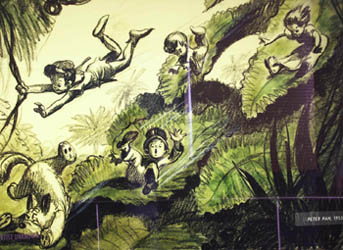 |
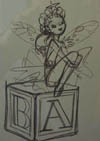 |
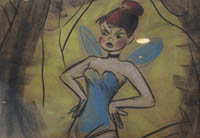 |
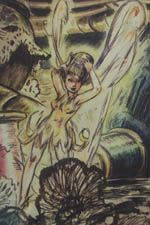 |
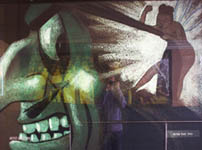 |
![]() Walt Disney first
came upon the idea of making an animated film based on "Peter Pan" around
1935. Four years later, he acquired the film rights to to
Sir James Barrie's tremendously popular stage play (1904) and book (1911)
from
the Great Ormond Street Hospital in London for £
5,000 -Barrie had given the hospital the rights to his play. Disney
then ordered concept drawings for Peter Pan, which, offered a far
darker rendering of the fantasy.
Walt Disney first
came upon the idea of making an animated film based on "Peter Pan" around
1935. Four years later, he acquired the film rights to to
Sir James Barrie's tremendously popular stage play (1904) and book (1911)
from
the Great Ormond Street Hospital in London for £
5,000 -Barrie had given the hospital the rights to his play. Disney
then ordered concept drawings for Peter Pan, which, offered a far
darker rendering of the fantasy.
![]() Walt Disney was
always interested in acquiring James Barrie's Peter Pan as a property
for his studio. In 1937, the year of Barrie's death and before Snow
White was released, a Disney memo was sent to Disney's London representative
to obtain the rights to PETER PAN immediately. Disney has two reasons for
concern according to the memo. First, he feared that when Snow White
came out and people saw what the studio had done, the prices for potential
properties would soar sky high. Second, he feared that Max Fleischer would
obtain the rights to Peter Pan and ruin the project. Disney was
successful in finally obtaining the rights but it was over a decade before
the animated feature was made.
Walt Disney was
always interested in acquiring James Barrie's Peter Pan as a property
for his studio. In 1937, the year of Barrie's death and before Snow
White was released, a Disney memo was sent to Disney's London representative
to obtain the rights to PETER PAN immediately. Disney has two reasons for
concern according to the memo. First, he feared that when Snow White
came out and people saw what the studio had done, the prices for potential
properties would soar sky high. Second, he feared that Max Fleischer would
obtain the rights to Peter Pan and ruin the project. Disney was
successful in finally obtaining the rights but it was over a decade before
the animated feature was made.
![]() The
animated version of Peter Pan was one of many Disney projects cancelled
or delayed by World War II. After the war, Disney and animators
resumed plans for the film, and in 1950 it began in earnest.
The
animated version of Peter Pan was one of many Disney projects cancelled
or delayed by World War II. After the war, Disney and animators
resumed plans for the film, and in 1950 it began in earnest.
![]() The
movie was shot entirely in live-action first: the actors recorded
their lines, "performing" in costume for a movie version of "Peter Pan"
that was made for the animators so they could capture the actors' expressions
and movements.
The
movie was shot entirely in live-action first: the actors recorded
their lines, "performing" in costume for a movie version of "Peter Pan"
that was made for the animators so they could capture the actors' expressions
and movements.
![]() Disney's version
of "Peter Pan" marked the first time that Peter was actually played by
a boy. In the stage versions and the silent movie version from the 1920s,
a woman played Peter.
Disney's version
of "Peter Pan" marked the first time that Peter was actually played by
a boy. In the stage versions and the silent movie version from the 1920s,
a woman played Peter.
![]() The name Wendy was invented by J.M. Barrie for his
play Peter Pan. The name enjoyed a brief resurgence in popularity
during the mid-1960s when the Beach Boys had a hit with the song "Wendy"
(a name Beach Boy Brian Wilson gave to his daughter as well).
The name Wendy was invented by J.M. Barrie for his
play Peter Pan. The name enjoyed a brief resurgence in popularity
during the mid-1960s when the Beach Boys had a hit with the song "Wendy"
(a name Beach Boy Brian Wilson gave to his daughter as well).
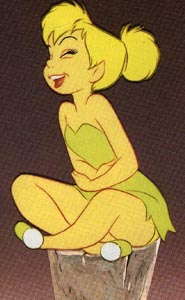
![]() Depicting
the character of Tinker Bell in an animated film posed something of a challenge
for Disney -- on stage she had always been represented by a spot of light
and tinkling bells. Early conceptions of a visible, human-like fairy Tinker
Bell were rejected for not being "sweet and dainty" enough, and for looking
too much like "a little nite club dame". Eventually, as Canemaker wrote,
"Tinker Bell was designed with the knowledge that her acting would all
be done in pantomime, with a face that would register her emotions clearly,
a simple costume that would not clutter up her movements, and sex appeal
to charm the viewer." As rendered by animator Marc Davis, based on the
model of actress Margaret Kerry (who also voiced a mermaid in Peter
Pan), Tinker Bell became the now-familiar winged blonde coquette, her
curvaceous figure clothed in a short green dress.
Depicting
the character of Tinker Bell in an animated film posed something of a challenge
for Disney -- on stage she had always been represented by a spot of light
and tinkling bells. Early conceptions of a visible, human-like fairy Tinker
Bell were rejected for not being "sweet and dainty" enough, and for looking
too much like "a little nite club dame". Eventually, as Canemaker wrote,
"Tinker Bell was designed with the knowledge that her acting would all
be done in pantomime, with a face that would register her emotions clearly,
a simple costume that would not clutter up her movements, and sex appeal
to charm the viewer." As rendered by animator Marc Davis, based on the
model of actress Margaret Kerry (who also voiced a mermaid in Peter
Pan), Tinker Bell became the now-familiar winged blonde coquette, her
curvaceous figure clothed in a short green dress.
![]() Tink's alter ego Margaret Kerry explained in a February 2002 interview:
"Lots
of people don't understand all this. They think the entire movie comes
from the animator's head, but I say wait a minute--Marc Davis [Tinker Bell's
animator] is a man's man--how does he know how a 31/2-inch sprite is going
to move, get angry, or stamp her foot? And how does he know what kind of
emotion would go behind that? How does he know how Wendy's skirt will wrap
when she walks? Or flies for that matter? What Marc did was take something
and then exaggerate it so it was more truly delightful." During her audition,
Margaret Kerry says, it was her pantomime of Tinker Bell standing on a
hand mirror sizing up her hips that got her the part. Other scenes such
as that of the pixie stuck in a keyhole, hips gratuitously wriggling in
a rear-angle shot lent an uncharacteristically saucy element to this Disney
classic based on the James M. Barrie story. "You just didn't get shot like
that in a family movie," she admits. "There were a lot of people who thought
Tink was just a little too sexy. But what Marc [Davis] told me--how he
got away with it--was keeping the bottom half womanly but drawing the top
half as a little girl."
Tink's alter ego Margaret Kerry explained in a February 2002 interview:
"Lots
of people don't understand all this. They think the entire movie comes
from the animator's head, but I say wait a minute--Marc Davis [Tinker Bell's
animator] is a man's man--how does he know how a 31/2-inch sprite is going
to move, get angry, or stamp her foot? And how does he know what kind of
emotion would go behind that? How does he know how Wendy's skirt will wrap
when she walks? Or flies for that matter? What Marc did was take something
and then exaggerate it so it was more truly delightful." During her audition,
Margaret Kerry says, it was her pantomime of Tinker Bell standing on a
hand mirror sizing up her hips that got her the part. Other scenes such
as that of the pixie stuck in a keyhole, hips gratuitously wriggling in
a rear-angle shot lent an uncharacteristically saucy element to this Disney
classic based on the James M. Barrie story. "You just didn't get shot like
that in a family movie," she admits. "There were a lot of people who thought
Tink was just a little too sexy. But what Marc [Davis] told me--how he
got away with it--was keeping the bottom half womanly but drawing the top
half as a little girl."
![]() The original print of the 1924 silent movie Peter Pan was
purchased by Disney in 1938 when it began developing the animated version
of the James M. Barrie tale, finally released
in 1953.
The original print of the 1924 silent movie Peter Pan was
purchased by Disney in 1938 when it began developing the animated version
of the James M. Barrie tale, finally released
in 1953.
![]() A sequel entitled Peter Pan: Return To Never
Land was released theatrically in February 2002.
A sequel entitled Peter Pan: Return To Never
Land was released theatrically in February 2002.
 James
Matthew Barrie was born in 1860 in Scotland. For the first six years of
his life, he lived in the shadow of his elder brother David. Just before
his fourteenth birthday, David was killed in a skating accident. Barrie
soon realised that, by dying so young, David would remain a boy forever
in the minds of all those who had known him.
James
Matthew Barrie was born in 1860 in Scotland. For the first six years of
his life, he lived in the shadow of his elder brother David. Just before
his fourteenth birthday, David was killed in a skating accident. Barrie
soon realised that, by dying so young, David would remain a boy forever
in the minds of all those who had known him.
In 1897, Barrie was a successful
writer both in Britain and the United States. He was married to the actress
Mary Ansell but they had no children. This didn't stop him from meeting
children. One of these was a four-year-old girl called Margaret who called
Barrie "my friendy". Because she couldn't pronounce her r's, the word "friendy"
often sounded like
"fwendy" or "wendy". She died when she was six
but Barrie immortalised her in Peter Pan by calling his heroine Wendy,
a name that he created.
 Barrie's
London home was very close to Kensington Gardens and it was here that he
first met the Llewellyn Davies boys George, Jack and Peter. He described
their mother as "the most beautiful creature I had ever seen" and soon
he was a frequent visitor to their house where he would tell the boys stories.
One of these stories was about the youngest boy, Peter, who, according
to Barrie, would one day fly away to Kensington Gardens so that he might
be a boy forever. When children died, Peter would take them on a
journey to a place called Never Never Land. When George heard the story,
he said that "dying must be an awfully big adventure!". Barrie wrote the
words down. They would later became the most famous words spoken in Peter
Pan.
Barrie's
London home was very close to Kensington Gardens and it was here that he
first met the Llewellyn Davies boys George, Jack and Peter. He described
their mother as "the most beautiful creature I had ever seen" and soon
he was a frequent visitor to their house where he would tell the boys stories.
One of these stories was about the youngest boy, Peter, who, according
to Barrie, would one day fly away to Kensington Gardens so that he might
be a boy forever. When children died, Peter would take them on a
journey to a place called Never Never Land. When George heard the story,
he said that "dying must be an awfully big adventure!". Barrie wrote the
words down. They would later became the most famous words spoken in Peter
Pan.
Barrie wrote the story several times before he decided to turn it into a play in 1903. The play's producer thought it would be a disaster but the story of The Boy Who Wouldn't Grow Up was an instant success.
J. M. Barrie's relationship with the Llewellyn
family continued and soon two more boys were born, Michael and Nico. Michael
soon became Barrie's favourite and he even took photographs of him dressed
as Peter Pan. The boys' father, Arthur Llewellyn Davies, who had always
resented Barrie's interference with his family, died of cancer. When Sylvia
also died of cancer, Barrie took on the role of the boys' father. But soon
tragedy struck again. In March 1915, George was killed, a victim of the
war. In May 1921, a few weeks before his 21st birthday, Michael, who could
not swim, drowned in the Thames. Barrie later referred to him as the boy
"that will never be old".
![]() Peter Pan was first performed on 27 December 1904. It was then performed
every year until its run was interrupted by war in 1939-1940. It then continued
until 1969. The play is usually performed at Christmas time: on average
there are 25 productions of Peter Pan in Britain at Christmas.
Peter Pan was first performed on 27 December 1904. It was then performed
every year until its run was interrupted by war in 1939-1940. It then continued
until 1969. The play is usually performed at Christmas time: on average
there are 25 productions of Peter Pan in Britain at Christmas.
![]() In the theatre, the part of Peter Pan is usually played by a woman. This
is because an old law said that child actors could not work after nine
o'clock at night. The first actress to play the part was Nina Boucicault.
In the theatre, the part of Peter Pan is usually played by a woman. This
is because an old law said that child actors could not work after nine
o'clock at night. The first actress to play the part was Nina Boucicault.
![]() Each year on Christmas Day there is a Peter Pan swimming competition in
London. There is also a car ferry called Peter Pan!
Each year on Christmas Day there is a Peter Pan swimming competition in
London. There is also a car ferry called Peter Pan!
![]() Barrie said that he wanted the royalties from productions of Peter Pan
to go to the Great Ormond Street Hospital for Sick Children in London.
When this arrangement legally expired in 1988, the British parliament decided
to change the copyright law so that the hospital would continue receiving
money (including an estimated half a million dollars from Steven Spielberg's
movie, Hook).
Barrie said that he wanted the royalties from productions of Peter Pan
to go to the Great Ormond Street Hospital for Sick Children in London.
When this arrangement legally expired in 1988, the British parliament decided
to change the copyright law so that the hospital would continue receiving
money (including an estimated half a million dollars from Steven Spielberg's
movie, Hook).
![]() Charles Laughton is one of the most famous actors to have played the part
of Hook. Barrie thought that Hook had to terrify both children and adults.
The part of Hook is traditionally played by the same actor as Mr. Darling.
Charles Laughton is one of the most famous actors to have played the part
of Hook. Barrie thought that Hook had to terrify both children and adults.
The part of Hook is traditionally played by the same actor as Mr. Darling.
![]() Barrie erected a statue of Peter Pan in Kensington Gardens. He did it in
the middle of the night so that people would think it had appeared by magic.
The statue was based on the photographs Barrie had taken of Michael Llewelyn
Davies.
Barrie erected a statue of Peter Pan in Kensington Gardens. He did it in
the middle of the night so that people would think it had appeared by magic.
The statue was based on the photographs Barrie had taken of Michael Llewelyn
Davies.
![]() In 1920, Barrie wrote a film version for Paramount. Charlie Chaplin was
going to play the part of Peter. A silent film was made in 1924 but not
with Chaplin.
In 1920, Barrie wrote a film version for Paramount. Charlie Chaplin was
going to play the part of Peter. A silent film was made in 1924 but not
with Chaplin.
|
||||||||||||